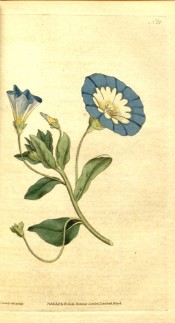Convolvulus tricolor L.
Fully hardy, bushy, upright, then spreading perennial, usually grown as an annual, with funnel-shaped royal-blue flowers with a lighter centre in succession throughout summer. Many cultivars are available. To 40cm. A very useful bedding and edging plant. [RHSE, Hortus].
Horticultural & Botanical History
‘This species has usually been called Convolvulus minor by gardeners, by way of distinguishing it from Convolvulus purpureus, to which we have given the name of major. It is a very pretty annual; a native of Spain, Portugal, and Sicily, and very commonly cultivated in gardens. The most usual colours of its blossoms are blue, white, and yellow, whence its name of tricolor; but there is a variety of it with white, and another with striped blossoms. [BM t.27/1787]. Introduced to Britain in 1629. [JD]. Flore des Serres figures the variety vittatus with yellow-centred flowers. [FS pl.VI 12e Liv./1847].
History at Camden Park
Listed in the 1850 and 1857 catalogues [H.82/1850]. It is possible that this plant was obtained as seed from James Carter, Florist and Seedsman of High Holborn, with whom an order for 8 varieties of convolvulus seed was placed on 8th of April 1846. [MP A2933-1, p.128].
Notes
Convolvulus minor Gilib. = Convolvulus arvensis L., ‘Small bindweed’, a weedy species from Europe.
Published Feb 07, 2009 - 03:21 PM | Last updated Jul 16, 2010 - 03:26 PM
| Family | Convolvulaceae |
|---|---|
| Category | |
| Region of origin | Southern Europe, north Africa |
| Synonyms |
|
| Common Name | Dwarf morning glory |
| Name in the Camden Park Record | Convolvulus minor |
| Confidence level | high |
